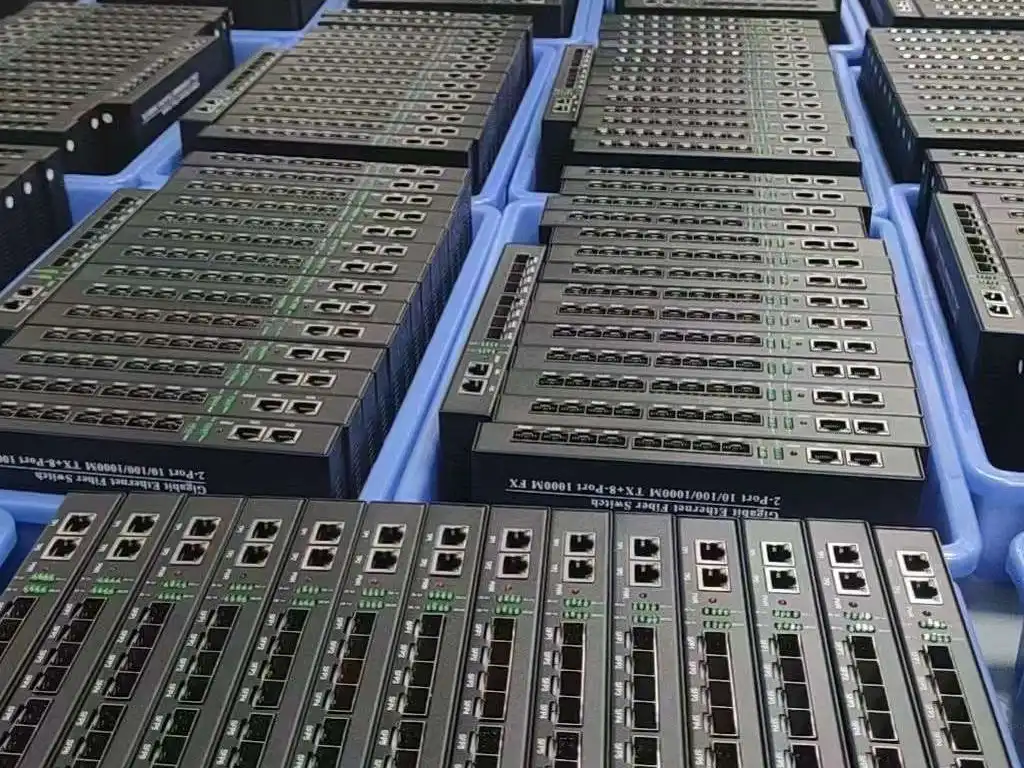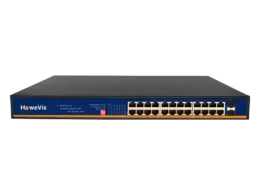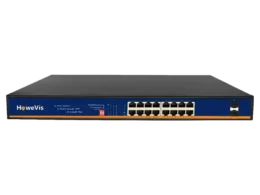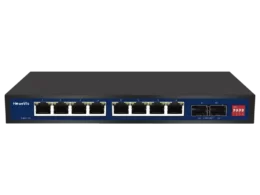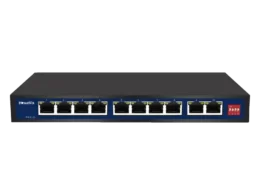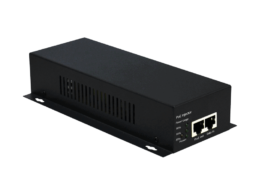Power over Ethernet (PoE) technology has revolutionized how we power and connect devices in various industries, such as network switches and IP phones. With the use of Cat5 cables, PoE allows for seamless data transmission and eliminates the need for separate power sources for these devices. One notable advancement in powered devices is PoE+, a standard with higher power delivery capabilities than its predecessors. With PoE+, wired Ethernet connections can be established using Ethernet cabling, providing efficient power delivery to connected devices. With PoE+, both data and power can be transmitted over a single Ethernet cable, eliminating the need for separate power sources. This is especially useful when using cat5 cables to connect an IP phone or any other powered device (PD). In modern network setups, ethernet cabling, such as cat5 cables, is essential for powering devices like IP cameras, wireless access points, and VoIP phones. Additionally, gigabit ethernet and ethernet switches are crucial in this technology.
The adoption of Power over Ethernet (PoE+) networks has brought significant benefits, including simplified installation processes, reduced costs, and improved flexibility in device placement. PoE+ networks utilize IEEE 802.3at standards to deliver power and data over Ethernet cables, eliminating the need for separate power supplies and reducing the number of required pins. This technology enables devices to be powered and connected through a single Ethernet cable, making installing and managing network devices easier. Additionally, PoE+ networks can provide power sourcing equipment (PSE) capabilities, allowing them to supply power to connected devices such as IP cameras. By leveraging the power of Power over Ethernet (PoE+), organizations can streamline their network infrastructure while ensuring the reliable and efficient operation of connected devices. PoE+ is a technology standardized by the Institute of Electrical and Electronics Engineers (IEEE) that enables the transmission of both power and data over Ethernet cables. This eliminates the need for separate power sources for devices, reducing the number of cables and simplifying installation. With PoE+, organizations can easily connect devices such as IP phones, wireless access points, and security cameras to their network using a single Ethernet cable, known as a PoE+ cable. This not
Understanding the differences between PoE, PoE+, and PoE++ standards
To fully grasp the distinctions between PoE, PoE+, and PoE++ standards, it’s essential to understand that these IEEE specifications determine the maximum power levels supported by each powered device (PD) technology. Let’s delve into the details of the different PoE standards, such as IEEE, and explore their unique characteristics, including the number of pairs and pins.
Different PoE Standards
- PoE: Also known as Power over Ethernet (PoE), this IEEE standard enables the transmission of both data and power over a single Ethernet cable to powered devices (PDs). It supports maximum power delivery of up to 15.4 watts per port for different POE standards, passive POE, POE switches, and POE devices.
- DC PoE+: Building upon the foundation of PoE, DC PoE+ enhances power delivery capabilities by providing up to 30 watts per port. With a switch, DC PoE+ can efficiently power multiple devices in pairs. This increased power capacity allows for more demanding devices, such as PoE switches, to be powered through a PoE network connection. These devices can now receive power and data simultaneously over an Ethernet connection using DC power pairs.
- PoE++: The latest advancement in Power over Ethernet technology is called PoE++ or 802.3bt. This technology is used to power devices such as DC switches and can deliver power to multiple pairs of devices. This standard takes power delivery to new heights, supporting even higher wattage levels of up to 60 or 100 watts per port using Poe switches. The standard adheres to the DC power over ethernet standards and ensures efficient power transmission through pairs of cables.
Standards Defined by IEEE
These different PoE switches, which provide power and data transmission over a single Ethernet cable, adhere to the Power over Ethernet (PoE) standards set by the Institute of Electrical and Electronics Engineers (IEEE), an organization responsible for establishing industry-wide technical standards. These standards ensure efficient and reliable power delivery to devices such as IP cameras and wireless access points, eliminating the need for separate DC power sources. IEEE has developed these specifications for networking environments to cater to various power requirements, including PoE switches and adherence to PoE standards. These standards ensure reliable power delivery through power transmission over Ethernet pairs.
Differences in Power Delivery
The primary distinction among these standards lies in their respective power delivery capacities, especially regarding pairs and PoE switches.
- With a standard PoE switch, devices can receive up to 15.4 watts of power per port, making it ideal for powering pairs of devices simultaneously. This is suitable for powering devices such as IP phones, wireless access points, and small surveillance cameras with the help of PoE switches. PoE switches are designed to provide power and data transmission over Ethernet cables, adhering to PoE standards.
- In contrast, PoE+ offers double the power capacity with a maximum limit of 30 watts per port, making it ideal for switching pairs. This increase in power capacity allows for powering devices with higher energy demands, like pan-tilt-zoom (PTZ) cameras and video conferencing systems, making it compatible with the latest PoE switch standards. These switches provide power over Ethernet to devices through pairs of twisted-pair cables.
- The PoE++ switch takes power delivery to the next level, supporting up to 60 or 100 watts per port for pairs. This enables the powering of devices with even greater energy requirements, including high-performance wireless access points, digital signage displays, advanced security cameras, and PoE switches. With a PoE switch, you can easily pair these devices and provide power and data connectivity in a single cable.
Benefits of Higher Power Levels
The switch from PoE to PoE+ and PoE++ brings several advantages, making it a powerful pair.
- Flexibility: With a higher power capacity, organizations can deploy a wider range of devices, including PoE switches, without worrying about power limitations. This allows for greater flexibility in pairing various devices together, more flexibility in network design and device selection, especially when using a PoE switch, and even greater flexibility in network configuration.
- Simplified Deployment: A PoE switch’s ability to deliver power over Ethernet cables eliminates the need for separate power sources and reduces installation complexities. It simplifies deployment processes and saves time and costs.
- Future-proofing: As technology advances, devices are likely to demand more power. By adopting higher PoE standards like PoE+ or PoE++, organizations can future-proof their networks and ensure they have the necessary infrastructure to support upcoming devices.
Benefits and features of PoE+ technology
PoE+ technology, also known as Power over Ethernet Plus, offers a range of benefits and features that make it an attractive option for powering network devices. Let’s explore some of the advantages of PoE+ in more detail:
Power Delivery Capabilities
One of PoE+’s primary advantages is its power delivery capabilities. This technology allows devices to be powered remotely without needing separate electrical outlets. This eliminates the hassle of finding available power sources near each device location.
By utilizing PoE+, you can simplify installation by reducing the cables required for network devices. Instead of needing both a data cable and a power cable, PoE+ combines both functions into a single Ethernet cable. This not only saves time but also reduces clutter and improves overall aesthetics.
Greater Flexibility in Device Placement
Another significant benefit offered by PoE+ is greater flexibility in device placement. Since it eliminates the dependency on nearby power sources, you have more freedom to position your network devices wherever they are needed most. Whether it’s mounting IP cameras on ceilings or deploying wireless access points in hard-to-reach areas, PoE+ allows for convenient device placement without being limited by proximity to electrical outlets.
With traditional power delivery methods, relocating devices involves complex rewiring or additional infrastructure modifications. However, with PoE+, you can easily move your network devices within the reach of an Ethernet cable connection, providing added convenience and cost savings.
Enhanced Scalability and Efficiency
PoE+ technology also offers enhanced scalability and efficiency for network deployments. You can efficiently manage multiple powered devices from a single location by utilizing centralized power sourcing equipment (PSE), such as switches or midspans.
This centralized approach simplifies maintenance tasks like firmware updates or troubleshooting since all connected devices can be managed from one central point. It enables efficient power management by allowing administrators to monitor and control power usage, ensuring optimal energy efficiency across the network.
Cost Savings and Future-Proofing
Implementing PoE+ technology can lead to significant cost savings. You can save on installation costs associated with hiring electricians or purchasing additional power supplies by eliminating the need for separate electrical wiring. The reduced number of cables and power outlets required also translates into lower material costs.
Furthermore, PoE+ offers future-proofing capabilities by providing higher power delivery than standard PoE. This ensures that your network infrastructure is ready to support emerging technologies and power-hungry devices without requiring extensive upgrades or modifications.
Choosing between PoE, PoE+, and PoE++ switches
It’s essential to consider their power requirements. Different devices have varying power needs, and understanding the distinctions between Power over Ethernet (PoE), PoE+, and PoE++ switches can help you make an informed decision.
Power Requirements Matter
The first factor to consider is the power requirements of your network devices. This will determine which type of switch is suitable for your setup.
If your devices require more than 15.4 watts but less than 30 watts per port, then PoE+ switches are a great choice. These switches provide a higher power output than standard PoE switches, making them ideal for devices such as wireless access points, IP cameras, and VoIP phones that consume more power.
On the other hand, if you have high-power applications demanding more than 30 watts per port, you should consider using switches that are compliant with the newer PoE++ standard. These switches offer even higher power output and are designed for power-hungry devices like pan-tilt-zoom cameras or outdoor access points with multiple radios.
Pros and Cons
Let’s take a closer look at the pros and cons of each switch type:
PoE Switches
- Pros:
- Simplifies installation by allowing both data and power to be transmitted over a single Ethernet cable.
- Eliminates the need for additional power supplies or outlets near network devices.
- Cons:
- Limited to providing a maximum of 15.4 watts per port.
- It is not suitable for devices that require higher power consumption.
PoE+ Switches
- Pros:
- Provides an increased power output of up to 30 watts per port.
- Supports a wide range of powered devices, including Wi-Fi access points, IP cameras, and VoIP phones.
- Cons:
- It is more expensive than standard PoE switches due to the increased power capabilities.
- Requires devices that are compatible with the PoE+ standard.
PoE++ Switches
- Pros:
- Offers the highest power output of up to 60 watts per port.
- Suitable for power-intensive devices such as PTZ cameras and high-performance access points.
- Cons:
- Limited availability and higher cost compared to PoE and PoE+ switches.
- Requires devices that are compliant with the PoE++ standard.
Making the Right Choice
Consider your network’s specific requirements to make an informed decision. Evaluate your devices’ power needs and determine whether they fall within the range of a standard PoE switch or if you require the increased power capabilities of a PoE+ or PoE++ switch.
Check for compatibility between your network devices and the chosen switch. Ensure that your devices support the corresponding standards (PoE, PoE+, or PoE++) to guarantee seamless integration and optimal performance.
Understanding and weighing these differences against your network’s requirements allows you to choose between PoE, PoE+, and PoE++ confidently switches to meet your specific needs.
Exploring various applications of PoE+ technology
PoE+ technology plays a crucial role in powering and connecting IP cameras in security systems. Using Ethernet cables, PoE+ enables these cameras to transmit video data efficiently. This eliminates the need for separate power adapters and simplifies the installation process. With PoE+, security professionals can set up IP cameras in strategic locations without worrying about the availability of nearby electrical outlets.
Wireless access points also greatly benefit from PoE+. These devices are often installed where electrical outlets may be scarce or inconveniently located. With PoE+, wireless access points can be easily powered and connected to the network using a single Ethernet cable. This simplifies the installation process and ensures a reliable power source for uninterrupted connectivity.
VoIP phones have become increasingly popular in modern communication systems. They rely on PoE+ technology for their power and network connection. With PoE+, VoIP phones receive power through the Ethernet cable, eliminating the need for separate power adapters or batteries. This makes deploying VoIP phones throughout an office or building easier without worrying about finding available electrical outlets at each location.
The applications of PoE+ extend beyond just security systems, wireless access points, and VoIP phones. Many other network devices can benefit from this technology as well:
- Network switches: PoE+ allows network switches to transmit data and deliver power over Ethernet cables.
- Network routers: Routers equipped with PoE+ capabilities simplify connectivity by eliminating the need for additional power sources.
- Fiber optic converters: These devices enable fiber optic connections while still utilizing PoE+ for powering.
- Wireless bridges: Using PoE+, wireless bridges can connect remote networks wirelessly while receiving power through the same Ethernet cable.
- Network storage devices: Devices like NAS (Network Attached Storage) units can be powered using PoE+, reducing clutter caused by multiple cables.
The versatility of PoE+ technology makes it an essential component in various applications across different industries. Its ability to transmit power and data simultaneously over Ethernet cables simplifies installation, reduces costs, and enhances flexibility.
Comparing the specifications of PoE, PoE+, and PoE++ switches
There are different standards to consider.
PoE switches deliver up to 15.4 watts per port, suitable for low-power devices.
PoE (Power over Ethernet) switches provide a power output of up to 15.4 watts per port. These switches are ideal for connecting low-power devices such as IP phones, wireless access points, and IP cameras. You can conveniently power these devices with PoE switches without needing separate power cables or adapters.
Pros:
- Simplifies installation by eliminating the need for additional power cables.
- Cost-effective solution for powering low-power devices.
- Reduces cable clutter and simplifies network management.
Cons:
- Limited power output may not be sufficient for high-power devices.
- It is unsuitable for applications requiring more than 15.4 watts per port.
PoE+ switches provide up to 30 watts per port, catering to a wider range of devices with higher power requirements.
PoE+ (Power over Ethernet Plus) switches offer an increased power output of up to 30 watts per port. This enhanced capability makes them suitable for a broader range of devices with higher power requirements. Examples include PTZ (pan-tilt-zoom) cameras, video conferencing systems, and Wi-Fi access points with multiple radios.
Pros:
- Provides more power than standard PoE switches.
- Supports a wider range of devices with higher power demands.
- Offers greater flexibility in device selection.
Cons:
- May require Cat5e or Cat6 cables instead of Cat5 due to increased wattage.
- Higher cost compared to standard PoE switches due to increased power capabilities.
PoE++ switches support up to 60 or 100 watts per port, enabling high-power devices such as pan-tilt-zoom cameras and access points with multiple radios.
PoE++ (Power over Ethernet++) switches take power delivery to another level by supporting up to 60 or even 100 watts per port. These switches are designed for applications that demand significant power, such as PTZ cameras with heaters and blowers, high-performance Wi-Fi access points, and digital signage displays.
Pros:
- Provides ample power for high-power devices.
- Enables the use of advanced features in devices that require more wattage.
- Future-proof solution for demanding applications.
Cons:
- Requires Cat6 or Cat6a cables to handle the higher wattage.
- Higher cost compared to PoE+ switches due to increased power capabilities.
Advanced PoE technologies: PoE++, UPoE, and PoE+
In the world of Power over Ethernet (PoE) technology, several advanced options offer increased power delivery capabilities. These include Universal Power over Ethernet (UPoE), PoE++, and PoE+. Each of these technologies has unique features and benefits, catering to various power requirements for various devices.
UPoE: Cisco’s proprietary high-power technology
UPoE, also known as Universal Power over Ethernet, is a proprietary technology developed by Cisco. It takes the concept of PoE to even greater heights by supporting higher power levels than PoE++ and PoE+. With UPoE, you can power various power-hungry devices, such as high-end video conferencing systems, virtual desktop infrastructure (VDI) endpoints, and building management systems.
Here are some key points about UPoE:
- Higher Power Levels: UPoE supports up to 60 watts per port, making it ideal for powering devices requiring substantial energy.
- Enhanced Flexibility: The increased power levels offered by UPoE allow for more flexibility in deploying power-hungry equipment without additional electrical outlets.
- Cisco Exclusive: It’s important to note that UPoE is a Cisco-specific technology and may not be compatible with non-Cisco network equipment.
PoE+: The intermediate standard
Poe+, also known as IEEE 802.3at standard or Type 2 PoE, is an intermediate standard between traditional PoE and the newer high-power standards like PoE++ and UPoE. It offers higher power delivery capabilities than conventional PoE while still falling short of the levels its successors provide.
Here’s what you need to know about PoE+:
- Increased Power Delivery: PoE+ can deliver up to 30 watts per port, double the power offered by traditional PoE.
- Wider Range of Powered Devices: With its higher power output, PoE+ can support a broader range of powered devices, including IP phones, wireless access points, and IP cameras.
- Backward Compatibility: PoE+ switches are backward compatible with devices that comply with the original PoE standard (IEEE 802.3af).
PoE++: The latest standard for high-power delivery
PoE++, or IEEE 802.3bt standard or Type 4 PoE, represents the newest advancement in Power over Ethernet technology. It provides even greater power delivery capabilities than both PoE+ and UPoE.
Take note of these key features of PoE++:
- Increased Power Classes: PoE++ introduces new power classes (7 and 8), allowing power delivery of up to 90 watts per port. This enables the powering of devices such as pan-tilt-zoom (PTZ) cameras, video conferencing systems, and advanced access control systems.
- Wide Range Voltage Support: PoE++ supports a wide range of voltages, including both low voltage (24V) and high voltage (48V), making it compatible with a diverse array of powered devices.
- Improved Cable Utilization: By utilizing all four twisted pairs in Ethernet cables for power transmission, PoE++ achieves more efficient power delivery compared to previous standards.
The impact and benefits of PoE+
Now that you have a better understanding of the differences between PoE, PoE+, and PoE++ standards, as well as the benefits and features of PoE+ technology, you are equipped to make an informed decision. Whether you’re looking to power devices in a small office or deploy a large-scale network infrastructure, PoE+ offers significant advantages in terms of simplicity, cost-effectiveness, and flexibility.
By leveraging the power of Ethernet cables to transmit both data and electrical power, PoE+ eliminates the need for separate power sources and simplifies installation. This not only reduces costs but also provides greater freedom in device placement without being constrained by proximity to power outlets. With its increased power capacity compared to standard PoE, PoE+ enables the support of more demanding devices such as high-resolution IP cameras and wireless access points.
Incorporating PoE+ technology into your network infrastructure empowers you to streamline operations, enhance scalability, and future-proof your setup. So why wait? Take advantage of the numerous benefits that PoE+ has to offer by exploring suitable switches and implementing this innovative solution today!
FAQs
Can I use regular Ethernet cables with PoE+?
Yes! One of the advantages of using PoE+ is that it can work with standard Ethernet cables (Cat5e or higher). There is no need for special cabling infrastructure.
What are some common applications for PoE+ technology?
PoE+ technology finds application in various industries, such as security surveillance systems, VoIP phones, wireless access points, smart lighting systems, digital signage displays, and even charging stations for electric vehicles.
How do I know if my device is compatible with PoE+?
To determine if your device is compatible with PoE+, check the product specifications or consult the manufacturer. Look for indications such as “PoE+” or “802.3at” compatibility.
Can I mix PoE, PoE+, and PoE++ devices on the same network?
Yes, you can mix different PoE standards on the same network. However, it is essential to ensure that your switches support the appropriate power requirements for each device.
What is the maximum distance that PoE+ can transmit power?
The maximum distance that PoE+ can transmit power depends on various factors, such as cable quality and power requirements of the connected devices. Generally, most installations can achieve distances of up to 100 meters (328 feet).
